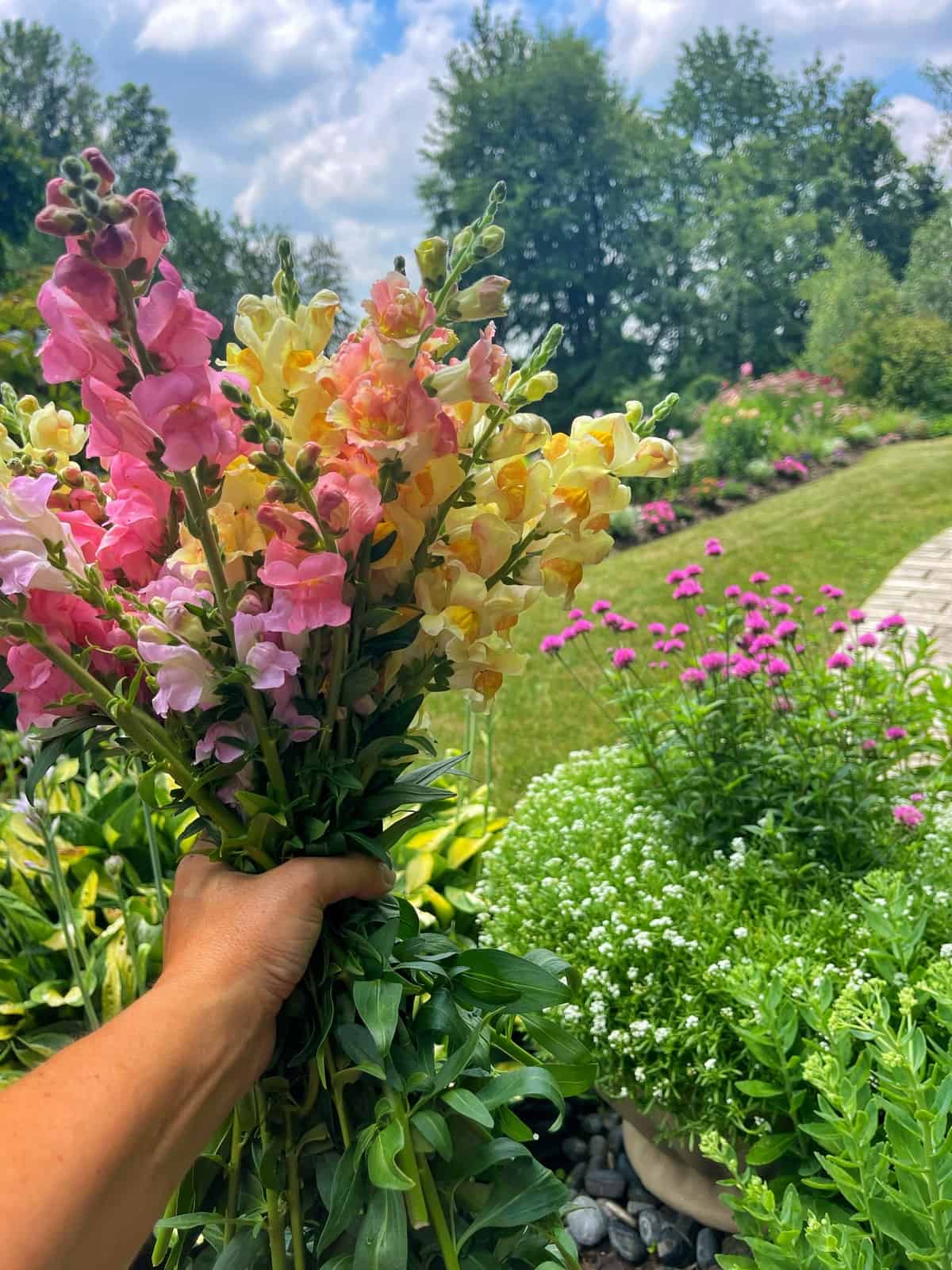Learn how to make snapdragons keep blooming all season with expert care tips, deadheading, pinching, and cutting flowers for continuous color in your garden.
Snapdragons are one of my absolute favorite flowers to grow. Their range of colors and whimsical shapes bring lots of joy and character to both my garden and bouquets. Over the years, I’ve learned some valuable tips to keep snapdragons blooming longer, ensuring continuous color throughout the season.
If you love snapdragons as much as I do and want to enjoy their beauty for as long as possible, then this post is for you. I’m sharing my tried-and-true methods to help you keep the blooms coming. Are you ready to get your bloom on? Let’s chat more about how to make those snapdragons keep blooming!
(Posts on stacyling.com may contain affiliate links. Click HERE for full disclosure.)

Choose the Right Variety
Selecting the right variety of snapdragons can make a big difference in their blooming potential. Opt for long-blooming or repeat-blooming snapdragon varieties such as:
- Rocket Series: Known for tall spikes and continuous blooms.
- Liberty Classic Series: Compact and great for borders, with extended blooming periods.
- Madame Butterfly Series: Fragrant and ruffled blooms that last longer.
- Potomac Series: Tall, sturdy snapdragons that produce long, strong stems.
- Chantilly Lace Series: Unique open-faced flower and known for their long blooming period.
Plant in the Right Spot
While snapdragons thrive in full sun to partial shade, they need at least 6 hours of sunlight daily to bloom well. Well-draining soil is crucial, as snapdragons dislike soggy roots. Amend your soil with compost to improve drainage and fertility. Want to drill down more on how to plant snapdragons and grow them from seed? Read this informative article that I wrote about snapdragon care for continuous blooms.

Watering Snapdragons: A Balanced Approach
Watering snapdragons requires a balanced approach, as both overwatering and underwatering can be detrimental to their flowering. While consistent moisture is key, if your soil retains too much moisture, it can lead to root rot and other problems.
The frequency of watering will vary depending on factors like your soil type, weather conditions, and the plant’s location. In general, aim to water deeply once or twice a week, allowing the soil to dry slightly between waterings. During hot, dry periods, more frequent watering may be necessary. Midsummer in my zone 6b garden, I am watering my snapdragons almost daily depending on the weather.
It’s also a good ideas to water your snapdragons early in the morning at the base of the plant to minimize evaporation and reduce the risk of fungal diseases. This method allows foliage to dry throughout the day and promotes healthier plants.
To ensure your snapdragons receive the right amount of moisture, you can use your finger to check the soil’s moisture level. If the top inch feels dry, it’s time to water. For more precise watering, consider using drip irrigation or soaker hoses, which deliver water directly to the roots and minimize waste.

Removing Spent Flowers: How to Deadhead Snapdragons
Deadheading (removing spent flowers) encourages snapdragons to produce more blooms. Here’s a detailed guide on how to deadhead snapdragon flowers.
- Identify Spent Blooms: Look for flowers that have faded or started to wilt.
- Use Sharp Tools: Use sharp scissors or pruners to make clean cuts, reducing the risk of plant damage.
- Cut Above the Leaves: Cut the spent flowers just above the next set of leaves or a lateral bud. This helps the plant focus its energy on producing new blooms rather than seeds.
- Regular Maintenance: Make deadheading a routine part of your gardening maintenance. Frequent removal of spent flowers promotes continuous blooming and keeps the plant looking tidy.
How to Make Snapdragons Keep Blooming: Snapdragon Fertilizer
Feed your snapdragons with a balanced slow-release fertilizer when planting to encourage lots of blooms. Avoid high-nitrogen fertilizers, which promote foliage growth at the expense of blooms. Organic options like compost or well-rotted manure can also provide steady nourishment. This year, I added a layer of worm castings to the raised beds in my cutting garden too.

Pinching Back Seedlings
Pinching back young snapdragon seedlings is a technique used to encourage bushier growth and more flower spikes. Here’s how to pinch back your snapdragon seedlings.
- Timing: Pinch back snapdragon seedlings when they reach about 6-8 inches tall. This timing allows the plant to develop a strong root system while still being young enough to redirect growth.
- Technique: Using your fingers or small, sharp scissors, pinch off the top inch of the plant, just above a set of leaves. This removes the terminal bud and encourages the plant to produce lateral branches.
While you don’t HAVE to do it, pinching promotes a fuller, more compact plant with way more flowering stems. This results in a more prolific blooming period and a healthier overall plant structure.
Mulching
To keep plants from stressing during the growing season, apply a 2-3″ layer of mulch around your snapdragons to help retain soil moisture and regulate temperature. Organic mulches like straw, shredded leaves, or wood chips work well and also improve soil quality as they decompose. With improved soil moisture and temperature regulation, the better your snapdragons will bloom during the changing seasons.

Pest and Disease Control: How to Make Snapdragons Keep Blooming
Healthy snapdragons are less susceptible to pests and diseases and will therefore, put out more blooms. Keep an eye out for common issues like aphids, spider mites, and rust. Before grabbing pesticides, try these alternative methods of organic pest and disease control to protect pollinators and other beneficial insects. Depending on the issue, use insecticidal soap for pests and neem oil for fungal issues, and remove any affected plant parts to prevent the spread of disease. (Do not compost!).
Overwintering Snapdragons
In mild climates, snapdragons can be treated as perennials. Mulch heavily in late fall to protect the roots from frost.
Companion Planting Ideas for Snapdragons
Pair snapdragons with other annuals and perennials that have similar care requirements. Companion planting can not only enhance your garden’s aesthetic, but also boost the health and vitality of your garden. Good companion plants for snapdragons include:

Snapdragons in the Cutting Garden
Snapdragons are one of my favorite flowers to grow in my cutting garden. I enjoy their beautiful colors and interesting shapes in my garden. They add a cheerful touch to any floral arrangement and are incredibly rewarding to grow.
Cutting and deadheading the flowers not only brings fresh blooms into the house but also encourages the plants to produce even more flowers, prolonging the snapdragon blooming season and ensuring continuous color in the garden. So if you are growing them, make sure you cut and enjoy them as often as you can!
Cutting Flowers to Encourage Reblooming
- Optimal Cutting Time: Cut snapdragon flowers early in the morning when they are the freshest.
- Cutting Technique: Use sharp scissors or pruners to cut the stems just above a set of leaves or a lateral bud. This encourages new growth and more blooms.
- Vase Care: Place cut flowers in a vase with fresh water immediately to prolong their vase life. Change the water every couple of days to keep the flowers fresh longer.

Blooming Time and Reblooming After Cutting
Snapdragons typically take about 8-10 weeks from seeding to their first bloom, so be patient with them while they grow. This timeline can vary depending on the growing conditions and the specific variety of snapdragon.
After cutting your flowers, snapdragons can rebloom within a few weeks. The exact time can vary, but with proper care, including regular watering, fertilizing, and deadheading, you can encourage continuous blooming throughout the season.
For more information on how to make snapdragons keep blooming, see this article from Cornell University Extension Office.
To drill down on more beginner gardening techniques and tips, please read these posts:
- Flower Gardening 101
- Growing a Cut Flower Garden for Beginners
- Container Garden Ideas for Beginners
- How to Start a Vegetable Garden
- Herb Gardening for Beginners
Do you love to grow snapdragons too? What are your best tips to keep the flowers coming? Let’s chat more about it in the comments below!
Thank you for visiting the blog today!
Enjoy your day! xo







